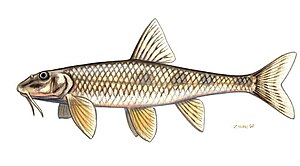Stone Greens
| Stone Greens | ||||||||||||
|---|---|---|---|---|---|---|---|---|---|---|---|---|

Stone Greens ( Romanogobio uranoscopus ) |
||||||||||||
| Systematics | ||||||||||||
|
||||||||||||
| Scientific name | ||||||||||||
| Romanogobio uranoscopus | ||||||||||||
| ( Agassiz , 1828) |
The stone gessling ( Romanogobio uranoscopus ), also stone gessling , is a rare Central European fish from the carp-like family . Until 1996 the species was in the genus Gobio .
features
The stone greenling has a spindle-shaped body that is flattened at the belly and has a long, thin tail stalk . Its snout underneath makes it easier for the fish to eat at the bottom of the water . In addition, the stone offspring has two barbels and medium-sized scales . The caudal fin is forked, while its anal fin is straight. Both fins have 1–2 dark patches. The back and sides of the stone leglet have 4-5 brownish saddle pads. The average size of the stone granite is 8–12 cm. These fish rarely grow up to 15 cm. The stone gudgeon can easily be confused with the gudgeon , which however has shorter barbels and a body that is not as thin and almost round as the stone gudgeon . The stone gudgeon is the only type of gudgeon to have a scaly throat.
Habitat and Distribution
The stone greenling prefers fast-flowing, oxygen-rich waters with a sandy-gravelly bottom. The preferred flow rate is between 0.5 and 1.5 m / s. It lives in the barbel region in the catchment area of the Danube . There are deposits in the Savinja , Sava and tributaries, Sora and tributaries, Mur tributaries in Slovenia, in the lower reaches of the Lavant and in the Danube in the Vienna area. The stone gregarious is now threatened with complete extinction . It is listed in Appendix II of the Fauna-Flora-Habitat Directive . Regionally it is already extinct, there are only small residual deposits. In the last century it was still common and was considered a dearly paid delicacy . Today it is no longer important in the economy . In November 2009, for the first time in over 100 years, stone shoots were found in the Lech in Bavaria.
Reproduction
It is one of the spring spawners as it spawns from May to June. The stone greenling is a substrate spawner , he seeks shallow and gravelly places in the flowing water to spawn. The males usually develop a spawning rash during the spawning season .
Way of life
The stone gregarious usually occurs in small packs. He prefers to stay at the bottom of the water. It feeds on insect larvae , worms and other small soil animals as well as on the growth.
Individual evidence
- ^ Bănărescu: The Freshwater Fishes of Europe. Aula-Verlag, Wiebelsheim 1999, ISBN 3-89104-044-X , p. 35. (Volume 5. Cyprinidae 2, Part III: Rhodeus to Capoeta)
- ↑ a b c d e f W. Honsig-Erlenburg, W. Petutschnig: Fish, lampreys, crayfish, large mussels . (= Nature Carinthia 1). Natural Science Association for Carinthia, Klagenfurt 2002, ISBN 3-85328-029-3 , p. 108f.
- ↑ Stone presslings in the Lech. Fish experts: "Sensational find" in Gersthofen. ( Memento of the original from November 22, 2009 in the Internet Archive ) Info: The archive link was automatically inserted and has not yet been checked. Please check the original and archive link according to the instructions and then remove this notice. on: augsburger-allgemeine.de , November 20, 2009.
literature
- Hermann Bayrle: Sure through the fishing test - freshwater fish mussels crayfish . Heintges teaching and learning system, 2006, ISBN 3-935510-74-8 .
Web links
- Information about the stone greens
- Steingreßling on Fishbase.org (English)
- Romanogobio uranoscopus inthe IUCN 2013 Red List of Threatened Species . Posted by: Freyhof, J. & Kottelat, M, 2008. Retrieved September 21, 2013.